GENERAL ASPECTS OF FRACTURE.pptx
Download as pptx, pdf0 likes112 views
Fractures can be classified based on their etiology, displacement, relationship to the external environment, and pattern. Traumatic fractures result from injury while pathological fractures occur through weakened bone. Stress fractures are caused by repetitive stress. Treatment involves emergency care like splinting, followed by definitive care such as closed or open reduction and immobilization. Rehabilitation aims to regain function. Complications can be immediate like shock, early like fat embolism, or late such as malunion. Proper treatment seeks to reduce fractures and preserve limb function.
1 of 38
Download to read offline
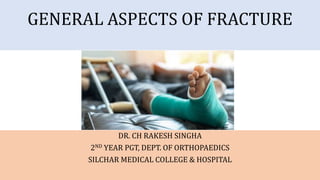


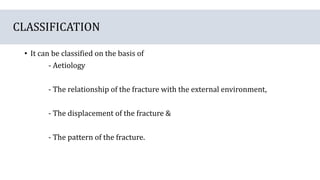
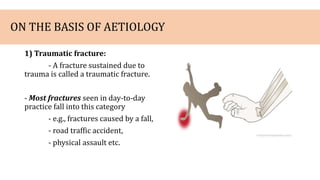
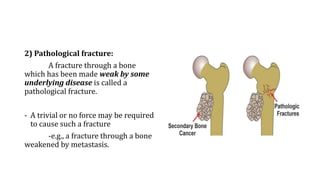

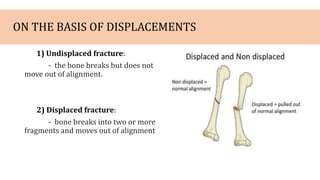
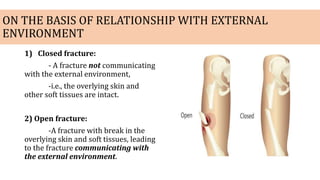



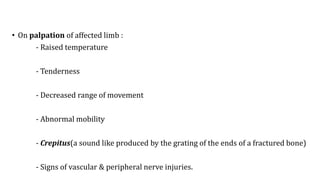
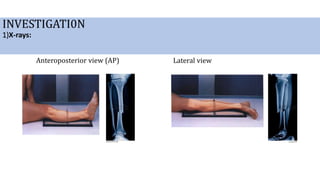
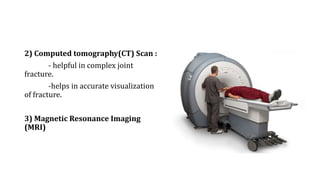
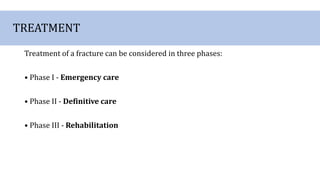
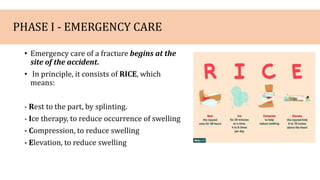
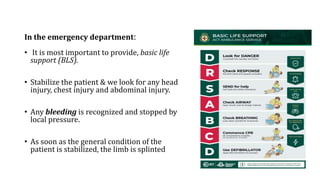




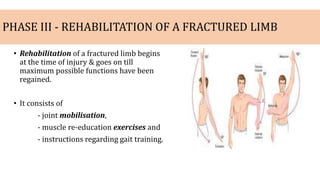
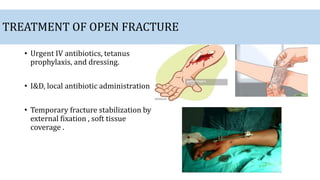
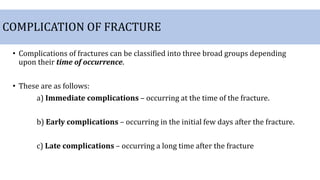

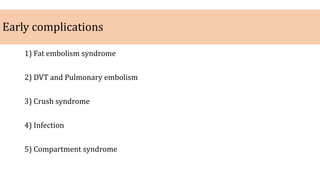


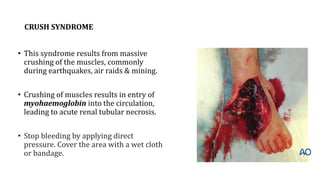
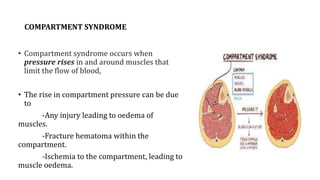

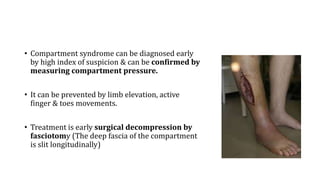
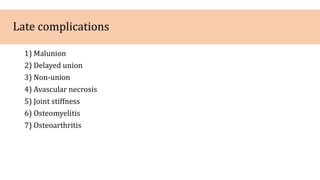

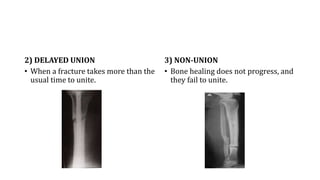
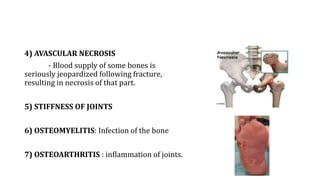

Ad
Recommended
Fracture,types and its management-MSN...
Fracture,types and its management-MSN...RNRM Shalini Rana
Ėý
This document discusses fractures, including their definition, causes, types, clinical manifestations, diagnosis, management, and complications. It defines a fracture as a break in the continuity of bone structure. Fractures can be caused by trauma or pathology and are classified as open or closed, complete or incomplete. The clinical signs of a fracture include pain, swelling, deformity, and loss of function. Diagnosis involves history, physical exam, x-rays, and sometimes CT or MRI. Management focuses on realignment, immobilization, and rehabilitation through various methods like casting, traction, or surgery. Potential complications include delayed healing, nonunion, malunion, and infection.Fractures
FracturesPallavi Lokhande
Ėý
The document outlines the learning objectives for a class on fractures, detailing definitions, causes, types, clinical manifestations, diagnostic measures, management, and complications associated with fractures. It discusses various classifications of fractures, the healing process, and emergency and definitive care phases, including treatment methods and nursing care considerations. Additionally, it highlights potential complications and the importance of rehabilitation and patient education.fracture management and reduction and its management
fracture management and reduction and its managementSwatiSheth5
Ėý
The document explains fractures as breaks in bone due to various traumatic events or metabolic diseases, detailing classifications based on communication with the external environment, fragments, direction, and displacement. It outlines the pathophysiology of fractures, healing processes, clinical manifestations, and diagnostic studies, followed by treatment phases including emergency care, definitive care, and rehabilitation. Complications of fractures such as systemic and local issues, along with their management, are also discussed.Fracture
FractureSuchithra Pv
Ėý
A fracture is a break or disruption in the continuity of bone caused by trauma or disease. Fractures are classified based on type, communication with the external environment, and anatomic location. Treatment involves emergency care like splinting, definitive care like closed or open reduction and immobilization with casting or internal fixation, and rehabilitation. Complications can be systemic like shock or local like injury to surrounding tissues or joints. Proper management of fractures aims to restore function and alignment of the injured bone.FRACTURES AND DISLOCATION MANAGEMENT.pptx
FRACTURES AND DISLOCATION MANAGEMENT.pptxAntwiBrainard
Ėý
The document discusses fractures, dislocations, and their treatment. It defines fractures and describes different types including closed/open, pathological, and stress fractures. Signs and symptoms of fractures and dislocations are outlined. The principles of diagnosing and treating fractures are described, including reduction, splinting, and casting. Factors that influence fracture healing are also mentioned.Complications of fractures
Complications of fracturesorthoprince
Ėý
The document discusses various complications that can arise from fractures, classifying them as either local or systemic, and whether they occur immediately, early, or late after the injury. Early local complications include vascular injuries, visceral injuries, soft tissue damage, hematoma formation, wound infections, and compartment syndrome. Systemic complications incorporate hypovolaemic shock, fat embolism, thromboembolism, sepsis, and crush syndrome. Late complications involve imperfect union like delayed union, non-union, malunion, or avascular necrosis. The treatment for each complication is also outlined.RIYA FRACTURE PPT.pptx
RIYA FRACTURE PPT.pptxanyaloreto813
Ėý
This document provides a detailed overview of fractures and dislocations by classification. It classifies fractures based on etiology, relationship to the external environment, displacement, complexity of treatment, quantum of force, and pattern. It also describes signs of fractures, inspection methods, and conservative treatment approaches like repositioning, immobilization using plaster of Paris, and agents to promote bone healing. Dislocations are classified as congenital or acquired, complicated or non-complicated, open or closed. Treatment approaches for acute dislocations include closed or open reduction followed by immobilization.Fracture
FractureJustin V Sebastian
Ėý
1) A fracture is a break in the continuity of bone caused by stress greater than the bone can withstand. This can damage surrounding soft tissues and organs.
2) Fractures are caused by direct blows, crushing forces, twisting motions, or muscle contractions. Types include simple, compound, impacted, and stress fractures.
3) Treatment involves reducing the fracture by aligning bone fragments, immobilizing the area, and rehabilitation to regain function and strength. Complications can include infection, delayed healing, or nonunion if not properly treated.4 Fractures 2010
4 Fractures 2010NorthTec
Ėý
This document describes fractures, including their classification, healing process, treatment methods, and potential complications. Fractures are breaks in bone continuity that can be open or closed. Treatment involves reduction, immobilization with casts or devices, and monitoring for complications like infection, compartment syndrome, blood clots, and fat embolism syndrome. Fracture healing is a multi-stage process of hematoma formation, new tissue growth, callus formation, bone consolidation and remodeling over several weeks or months.Musculo-skeletal disorders fracture and dislo.pptx
Musculo-skeletal disorders fracture and dislo.pptxDestaSiyoum
Ėý
The document outlines common musculoskeletal disorders, emphasizing soft tissue injuries like strains and sprains, and conditions such as dislocations and fractures. It details the causes, symptoms, management, and potential complications of these injuries, along with emergency and medical management strategies. Key points include the importance of immobilization, appropriate treatment for fractures, and factors influencing healing.Complications of fracture.pptx BY DR.BSP
Complications of fracture.pptx BY DR.BSPbharti pawar
Ėý
This document discusses various complications that can arise from fractures, classifying them as immediate, early, or late complications. Immediate complications include hypovolaemic shock and injuries to major blood vessels or internal organs. Early complications involve systemic issues like fat embolism, deep vein thrombosis, and crush syndrome, as well as local infections. Late complications are related to imperfect unions, including delayed union, non-union, malunion, and avascular necrosis. Many of these complications require aggressive emergency treatment to stabilize the patient and prevent long-term disabilities.Complications of fratures with specific reference to union
Complications of fratures with specific reference to unionAjitSwamy
Ėý
The document discusses various complications associated with fractures, categorizing them into immediate, early, and late complications, along with injuries related to nerves, blood vessels, muscles, and tendons. It highlights issues such as malunion, delayed and non-union, fat embolism, and myositis ossificans, including their etiology, consequences, diagnosis, and treatment options. Overall, it serves as a comprehensive guide to understanding the complications and management strategies related to fractures.BONE FRACTURES.pptx
BONE FRACTURES.pptxTRESFORDMAMBWE
Ėý
This document provides an overview of bone fractures including objectives, risk factors, causes, classifications, signs and symptoms, clinical assessment, fracture healing, complications, and management. It discusses the basic principles of fractures, how they are classified based on clinical presentation, anatomical location, etiology, and radiological appearance. Signs and symptoms, clinical assessment involving history and physical exam, and the stages of fracture healing are also summarized. Management of fractures includes reduction, immobilization, and rehabilitation.BONE FRACTURES.pptx
BONE FRACTURES.pptxhopekalunga
Ėý
This document provides an overview of bone fractures including:
- Risk factors like age, smoking, and osteoporosis that make fractures more likely.
- Types of fractures like closed versus open and classifications based on location and appearance on x-rays.
- Signs and symptoms like pain, swelling, deformity, and limited mobility.
- Stages of fracture healing like inflammation, new bone formation, and remodeling over several weeks.
- Management approaches like reducing displacement, immobilizing the bones, and rehabilitation.fracture-ppt.pptx
fracture-ppt.pptxHozanBKhudher
Ėý
This document discusses fractures, including their causes, types, healing process, and management. It begins by defining a fracture and listing common causes. It then describes the different types of fractures based on appearance, location in the bone, and stability. Next, it explains the typical 6-stage healing process: hematoma formation, granulation tissue formation, callus formation, ossification, consolidation, and remodeling. Factors that influence healing are also outlined. Finally, it lists the typical signs and symptoms of a fracture and provides an overview of the goals and initial steps in fracture management and assessment.FRACTURES NOTES PREPAIRED BY NATUNGA RONALD
FRACTURES NOTES PREPAIRED BY NATUNGA RONALDNatungaRonald1
Ėý
This document discusses fractures, including their causes, types, healing process, and management. It begins by defining a fracture and listing common causes. It then describes the different types of fractures based on appearance and location. The healing process is outlined in six stages: hematoma formation, granulation tissue formation, callus formation, ossification, consolidation, and remodeling. Factors that influence healing are also provided. Treatment involves assessment, emergency management, reduction and stabilization, and monitoring for complications. Methods of reduction include closed and open reduction, and devices like casting, internal fixation, and external fixation are used.Principles_of_fractures-1.ppt
Principles_of_fractures-1.pptAhmedMufleh1
Ėý
This document discusses principles of fractures, including definitions, causes, classification, clinical features, imaging, and treatment approaches. It covers the key points of fractures including:
- Definitions of closed vs open (compound) fractures and classifications systems for open fractures.
- Causes of fractures including trauma, stress, and pathological fractures.
- Clinical exam including history, signs, and imaging features.
- Treatment approaches for closed fractures including reduction, immobilization methods, and exercise/rehab.
- Additional discussion of open fractures including goals of treatment, stages of care, and considerations for fracture stabilization and soft tissue management.Fracture and its nursing management
Fracture and its nursing managementDurga Joshi
Ėý
The document provides information about a seminar on fractures presented by Ms. Durga Joshi. It defines a fracture as a break in the bone's continuity. It then lists the objectives of the seminar which are to define fracture, discuss causes and types, pathophysiology, clinical manifestations, and medical and nursing management. It proceeds to define types of fractures such as complete, incomplete, closed, and open fractures. It also discusses classification, causes, and complications of fractures as well as diagnosis, management including splinting and traction, and nursing care of patients with fractures.FRACTURE.pptx
FRACTURE.pptxAmandaScarlet2
Ėý
A fracture is a break or disruption in the continuity of bone. Fractures occur when stress placed on a bone exceeds its strength, and can be caused by direct impact, twisting, compression or muscle contraction. There are many types of fractures classified by the bone location and nature of the break. Treatment depends on the type and severity of fracture, and may involve casting, traction, closed or open reduction, internal or external fixation to realign and immobilize the bone while it heals. Nursing care focuses on pain management, preventing complications like infection, and helping the patient regain mobility and function.Emergency nursing and disaster care, fracture
Emergency nursing and disaster care, fractureSaminuJabir
Ėý
The document discusses the definition, causes, and types of fractures, detailing mechanisms of injury and categorizing fractures based on their characteristics and involvement with surrounding tissues. It outlines the signs and symptoms, principles of treatment, and repair processes associated with fractures, emphasizing the importance of immobilization and appropriate first aid measures. Additionally, specific fractures such as skull and clavicle fractures are addressed with their respective management strategies.FRACTURES.pptx basic presentation on trauma
FRACTURES.pptx basic presentation on traumagilbertmwanza67
Ėý
The document discusses fractures, defining them as complete or partial breaks in bones and outlining their classification based on clinical, radiological, anatomical, aetiological, and other specific factors. It emphasizes the importance of understanding fracture types for effective clinical management and treatment, detailing the processes of reduction, immobilization, and rehabilitation essential for recovery. Additionally, it highlights the stages of fracture healing and potential complications that may arise during the recovery process.Fractures healing complication & management
Fractures healing complication & managementDr Chandan Verma
Ėý
The document discusses different types and classifications of fractures. It describes fractures as being classified based on etiology into traumatic fractures caused by external forces or pathological fractures caused by underlying bone disease. Fractures are also classified based on displacement into displaced or non-displaced fractures. Additionally, fractures can be open or closed, simple or complex, and have different patterns such as transverse, linear, oblique, comminuted, or greenstick. Principles of fracture management include safe transport, assessment, resuscitation, radiography, reduction, and immobilization through external casting or internal fixation to achieve healing.fracture-types, symptoms, medical and surgical mgmtmanagement,
fracture-types, symptoms, medical and surgical mgmtmanagement,salianyashoda
Ėý
fracture-types, symptoms, medical and surgical mgmt 6. biomechanics of Fracture fixation 1.ppt
6. biomechanics of Fracture fixation 1.pptAlishbaFatima20
Ėý
Fractures are breaks or disruptions in the continuity of bone. They are classified based on type, communication with the external environment, anatomic location, appearance of fragments, and stability. Treatment goals are to realign bone fragments through reduction, immobilize through casting, traction, or fixation to maintain alignment, and restore function. Complications can include infection, compartment syndrome, venous thrombosis, and fat embolism syndrome. Early diagnosis and treatment of complications is important for proper healing and recovery from fractures.MUSCULOSKELETAL INJURY.ppt
MUSCULOSKELETAL INJURY.pptFredrickKemboy1
Ėý
The document provides information on injuries to the musculoskeletal system, including fractures, dislocations, sprains, strains, and compartment syndrome. It discusses signs and symptoms of various injuries, mechanisms of injury, classifications of fractures, assessment of injury severity, emergency medical care including splinting, and complications from orthopedic injuries. Key points covered include the importance of stabilizing injuries before transport, controlling bleeding, preventing further injury, and reducing pain.Chapter_29.ppt
Chapter_29.pptRaef4
Ėý
The document focuses on the anatomy and physiology of the musculoskeletal system, detailing the types of muscles, skeletal structure, and the roles of bones and joints. It reviews common musculoskeletal injuries including fractures, dislocations, sprains, and strains, as well as the mechanisms of injury and emergency medical care practices. Additionally, the document outlines assessment and splinting techniques for managing musculoskeletal injuries in emergency situations.Fractures
FracturesAmmar Alhakimi
Ėý
Introduction to fracture, mechanism, types, healing, and complication.. full information supported by real images and x-ray images.. Fracture
FractureSeif Said
Ėý
The document discusses a case involving a 12-year-old boy, Ali, who suffered a closed fracture in his right arm after falling into a canal when a dog crossed his path. It provides an overview of fractures, including types, causes, clinical manifestations, complications, assessment methods, and the medical and nursing management necessary for treatment and recovery. The document emphasizes the importance of proper immobilization, assessment for infection, patient education for home care, and documentation of the care process.DISABILITY COMPETENCIES.pptx
DISABILITY COMPETENCIES.pptxRakesh Singha
Ėý
The document discusses the implementation of disability competencies in health profession education in India, highlighting the need for medical graduates to be equipped with skills to care for patients with disabilities. It outlines the UN Convention on the Rights of Persons with Disabilities, the development of India's disability law in 2016, and the incorporation of disability education into medical curricula. Key components include teaching methods, disability etiquette, and the importance of advocacy and empathy in healthcare settings.DISTAL FEMUR, PATELLA, PROXIMAL TIBIA FRACTURE.pptx
DISTAL FEMUR, PATELLA, PROXIMAL TIBIA FRACTURE.pptxRakesh Singha
Ėý
The document outlines the types, mechanisms of injury, clinical features, investigations, and treatment options for fractures of the distal femur, patella, and proximal tibia. It details both nonoperative and operative treatments, complications, and emphasizes the importance of neurovascular assessment. Additionally, it describes the clinical signs of compartment syndrome and the necessity for immediate intervention in severe cases.More Related Content
Similar to GENERAL ASPECTS OF FRACTURE.pptx (20)
4 Fractures 2010
4 Fractures 2010NorthTec
Ėý
This document describes fractures, including their classification, healing process, treatment methods, and potential complications. Fractures are breaks in bone continuity that can be open or closed. Treatment involves reduction, immobilization with casts or devices, and monitoring for complications like infection, compartment syndrome, blood clots, and fat embolism syndrome. Fracture healing is a multi-stage process of hematoma formation, new tissue growth, callus formation, bone consolidation and remodeling over several weeks or months.Musculo-skeletal disorders fracture and dislo.pptx
Musculo-skeletal disorders fracture and dislo.pptxDestaSiyoum
Ėý
The document outlines common musculoskeletal disorders, emphasizing soft tissue injuries like strains and sprains, and conditions such as dislocations and fractures. It details the causes, symptoms, management, and potential complications of these injuries, along with emergency and medical management strategies. Key points include the importance of immobilization, appropriate treatment for fractures, and factors influencing healing.Complications of fracture.pptx BY DR.BSP
Complications of fracture.pptx BY DR.BSPbharti pawar
Ėý
This document discusses various complications that can arise from fractures, classifying them as immediate, early, or late complications. Immediate complications include hypovolaemic shock and injuries to major blood vessels or internal organs. Early complications involve systemic issues like fat embolism, deep vein thrombosis, and crush syndrome, as well as local infections. Late complications are related to imperfect unions, including delayed union, non-union, malunion, and avascular necrosis. Many of these complications require aggressive emergency treatment to stabilize the patient and prevent long-term disabilities.Complications of fratures with specific reference to union
Complications of fratures with specific reference to unionAjitSwamy
Ėý
The document discusses various complications associated with fractures, categorizing them into immediate, early, and late complications, along with injuries related to nerves, blood vessels, muscles, and tendons. It highlights issues such as malunion, delayed and non-union, fat embolism, and myositis ossificans, including their etiology, consequences, diagnosis, and treatment options. Overall, it serves as a comprehensive guide to understanding the complications and management strategies related to fractures.BONE FRACTURES.pptx
BONE FRACTURES.pptxTRESFORDMAMBWE
Ėý
This document provides an overview of bone fractures including objectives, risk factors, causes, classifications, signs and symptoms, clinical assessment, fracture healing, complications, and management. It discusses the basic principles of fractures, how they are classified based on clinical presentation, anatomical location, etiology, and radiological appearance. Signs and symptoms, clinical assessment involving history and physical exam, and the stages of fracture healing are also summarized. Management of fractures includes reduction, immobilization, and rehabilitation.BONE FRACTURES.pptx
BONE FRACTURES.pptxhopekalunga
Ėý
This document provides an overview of bone fractures including:
- Risk factors like age, smoking, and osteoporosis that make fractures more likely.
- Types of fractures like closed versus open and classifications based on location and appearance on x-rays.
- Signs and symptoms like pain, swelling, deformity, and limited mobility.
- Stages of fracture healing like inflammation, new bone formation, and remodeling over several weeks.
- Management approaches like reducing displacement, immobilizing the bones, and rehabilitation.fracture-ppt.pptx
fracture-ppt.pptxHozanBKhudher
Ėý
This document discusses fractures, including their causes, types, healing process, and management. It begins by defining a fracture and listing common causes. It then describes the different types of fractures based on appearance, location in the bone, and stability. Next, it explains the typical 6-stage healing process: hematoma formation, granulation tissue formation, callus formation, ossification, consolidation, and remodeling. Factors that influence healing are also outlined. Finally, it lists the typical signs and symptoms of a fracture and provides an overview of the goals and initial steps in fracture management and assessment.FRACTURES NOTES PREPAIRED BY NATUNGA RONALD
FRACTURES NOTES PREPAIRED BY NATUNGA RONALDNatungaRonald1
Ėý
This document discusses fractures, including their causes, types, healing process, and management. It begins by defining a fracture and listing common causes. It then describes the different types of fractures based on appearance and location. The healing process is outlined in six stages: hematoma formation, granulation tissue formation, callus formation, ossification, consolidation, and remodeling. Factors that influence healing are also provided. Treatment involves assessment, emergency management, reduction and stabilization, and monitoring for complications. Methods of reduction include closed and open reduction, and devices like casting, internal fixation, and external fixation are used.Principles_of_fractures-1.ppt
Principles_of_fractures-1.pptAhmedMufleh1
Ėý
This document discusses principles of fractures, including definitions, causes, classification, clinical features, imaging, and treatment approaches. It covers the key points of fractures including:
- Definitions of closed vs open (compound) fractures and classifications systems for open fractures.
- Causes of fractures including trauma, stress, and pathological fractures.
- Clinical exam including history, signs, and imaging features.
- Treatment approaches for closed fractures including reduction, immobilization methods, and exercise/rehab.
- Additional discussion of open fractures including goals of treatment, stages of care, and considerations for fracture stabilization and soft tissue management.Fracture and its nursing management
Fracture and its nursing managementDurga Joshi
Ėý
The document provides information about a seminar on fractures presented by Ms. Durga Joshi. It defines a fracture as a break in the bone's continuity. It then lists the objectives of the seminar which are to define fracture, discuss causes and types, pathophysiology, clinical manifestations, and medical and nursing management. It proceeds to define types of fractures such as complete, incomplete, closed, and open fractures. It also discusses classification, causes, and complications of fractures as well as diagnosis, management including splinting and traction, and nursing care of patients with fractures.FRACTURE.pptx
FRACTURE.pptxAmandaScarlet2
Ėý
A fracture is a break or disruption in the continuity of bone. Fractures occur when stress placed on a bone exceeds its strength, and can be caused by direct impact, twisting, compression or muscle contraction. There are many types of fractures classified by the bone location and nature of the break. Treatment depends on the type and severity of fracture, and may involve casting, traction, closed or open reduction, internal or external fixation to realign and immobilize the bone while it heals. Nursing care focuses on pain management, preventing complications like infection, and helping the patient regain mobility and function.Emergency nursing and disaster care, fracture
Emergency nursing and disaster care, fractureSaminuJabir
Ėý
The document discusses the definition, causes, and types of fractures, detailing mechanisms of injury and categorizing fractures based on their characteristics and involvement with surrounding tissues. It outlines the signs and symptoms, principles of treatment, and repair processes associated with fractures, emphasizing the importance of immobilization and appropriate first aid measures. Additionally, specific fractures such as skull and clavicle fractures are addressed with their respective management strategies.FRACTURES.pptx basic presentation on trauma
FRACTURES.pptx basic presentation on traumagilbertmwanza67
Ėý
The document discusses fractures, defining them as complete or partial breaks in bones and outlining their classification based on clinical, radiological, anatomical, aetiological, and other specific factors. It emphasizes the importance of understanding fracture types for effective clinical management and treatment, detailing the processes of reduction, immobilization, and rehabilitation essential for recovery. Additionally, it highlights the stages of fracture healing and potential complications that may arise during the recovery process.Fractures healing complication & management
Fractures healing complication & managementDr Chandan Verma
Ėý
The document discusses different types and classifications of fractures. It describes fractures as being classified based on etiology into traumatic fractures caused by external forces or pathological fractures caused by underlying bone disease. Fractures are also classified based on displacement into displaced or non-displaced fractures. Additionally, fractures can be open or closed, simple or complex, and have different patterns such as transverse, linear, oblique, comminuted, or greenstick. Principles of fracture management include safe transport, assessment, resuscitation, radiography, reduction, and immobilization through external casting or internal fixation to achieve healing.fracture-types, symptoms, medical and surgical mgmtmanagement,
fracture-types, symptoms, medical and surgical mgmtmanagement,salianyashoda
Ėý
fracture-types, symptoms, medical and surgical mgmt 6. biomechanics of Fracture fixation 1.ppt
6. biomechanics of Fracture fixation 1.pptAlishbaFatima20
Ėý
Fractures are breaks or disruptions in the continuity of bone. They are classified based on type, communication with the external environment, anatomic location, appearance of fragments, and stability. Treatment goals are to realign bone fragments through reduction, immobilize through casting, traction, or fixation to maintain alignment, and restore function. Complications can include infection, compartment syndrome, venous thrombosis, and fat embolism syndrome. Early diagnosis and treatment of complications is important for proper healing and recovery from fractures.MUSCULOSKELETAL INJURY.ppt
MUSCULOSKELETAL INJURY.pptFredrickKemboy1
Ėý
The document provides information on injuries to the musculoskeletal system, including fractures, dislocations, sprains, strains, and compartment syndrome. It discusses signs and symptoms of various injuries, mechanisms of injury, classifications of fractures, assessment of injury severity, emergency medical care including splinting, and complications from orthopedic injuries. Key points covered include the importance of stabilizing injuries before transport, controlling bleeding, preventing further injury, and reducing pain.Chapter_29.ppt
Chapter_29.pptRaef4
Ėý
The document focuses on the anatomy and physiology of the musculoskeletal system, detailing the types of muscles, skeletal structure, and the roles of bones and joints. It reviews common musculoskeletal injuries including fractures, dislocations, sprains, and strains, as well as the mechanisms of injury and emergency medical care practices. Additionally, the document outlines assessment and splinting techniques for managing musculoskeletal injuries in emergency situations.Fractures
FracturesAmmar Alhakimi
Ėý
Introduction to fracture, mechanism, types, healing, and complication.. full information supported by real images and x-ray images.. Fracture
FractureSeif Said
Ėý
The document discusses a case involving a 12-year-old boy, Ali, who suffered a closed fracture in his right arm after falling into a canal when a dog crossed his path. It provides an overview of fractures, including types, causes, clinical manifestations, complications, assessment methods, and the medical and nursing management necessary for treatment and recovery. The document emphasizes the importance of proper immobilization, assessment for infection, patient education for home care, and documentation of the care process.More from Rakesh Singha (7)
DISABILITY COMPETENCIES.pptx
DISABILITY COMPETENCIES.pptxRakesh Singha
Ėý
The document discusses the implementation of disability competencies in health profession education in India, highlighting the need for medical graduates to be equipped with skills to care for patients with disabilities. It outlines the UN Convention on the Rights of Persons with Disabilities, the development of India's disability law in 2016, and the incorporation of disability education into medical curricula. Key components include teaching methods, disability etiquette, and the importance of advocacy and empathy in healthcare settings.DISTAL FEMUR, PATELLA, PROXIMAL TIBIA FRACTURE.pptx
DISTAL FEMUR, PATELLA, PROXIMAL TIBIA FRACTURE.pptxRakesh Singha
Ėý
The document outlines the types, mechanisms of injury, clinical features, investigations, and treatment options for fractures of the distal femur, patella, and proximal tibia. It details both nonoperative and operative treatments, complications, and emphasizes the importance of neurovascular assessment. Additionally, it describes the clinical signs of compartment syndrome and the necessity for immediate intervention in severe cases.DDH (Developmental Dysplasia of Hip).pptx
DDH (Developmental Dysplasia of Hip).pptxRakesh Singha
Ėý
The document discusses developmental dysplasia of the hip (DDH), a condition characterized by abnormal hip development leading to dysplasia, subluxation, or dislocation, with an incidence of 1.4/1000 live births. Key risk factors include first-born status, female gender, family history, and breech position, with a range of clinical features and diagnostic tests such as ultrasonography and radiographs used for assessment. Treatment options vary by age and severity, including harnesses for infants, closed or open reduction, and osteotomies for older children and adolescents.CERAMICS IN ORTHOPAEDIC.pptx
CERAMICS IN ORTHOPAEDIC.pptxRakesh Singha
Ėý
Ceramics are widely used in orthopaedics due to their biocompatibility and mechanical properties. Ceramics are classified as bioinert, bioactive, or biodegradable based on how they interact with the body. Bioinert ceramics like alumina and zirconia are used for joint replacements due to their strength and wear resistance. Bioactive ceramics like hydroxyapatite and bioglass bond to bone and are used as bone grafts or coatings. Biodegradable ceramics like calcium phosphates degrade and are replaced by bone, making them suitable for drug delivery or bone voids. Ceramics have advantages for orthopaedic applications but alsoGENERAL APPROACH TO A TRAUMA PATIENT , ATLS .pptx
GENERAL APPROACH TO A TRAUMA PATIENT , ATLS .pptxRakesh Singha
Ėý
This document outlines the general approach to assessing and treating a trauma patient. It begins with defining trauma and noting that it is a leading cause of death in young populations. It then describes the ABCDE approach and concepts of Advanced Trauma Life Support (ATLS). The primary survey focuses on airway, breathing, circulation, disability, and exposure to identify life-threatening injuries. Interventions are then described for each area. The secondary survey involves a full history, physical exam, and diagnostic studies to evaluate other injuries before transfer to definitive care such as the operating room or ICU.SOFT TISSUE INJURY [Recovered].pptx
SOFT TISSUE INJURY [Recovered].pptxRakesh Singha
Ėý
This document discusses the classification of soft tissue injuries associated with fractures. It describes several classification systems, including Tscherne, Gustilo-Anderson, and AO, that grade soft tissue injuries based on factors like wound size, contamination, and bone and muscle involvement. Proper classification of soft tissue injuries is important for determining fracture management and predicting healing to help standardize treatment protocols.BIOMATERIALS IN ORTHOPAEDICS-1 (1).pptx
BIOMATERIALS IN ORTHOPAEDICS-1 (1).pptxRakesh Singha
Ėý
Biomaterials are natural or synthetic substances that can be tolerated by the human body and are commonly used in orthopedic devices. There are three generations of biomaterials: first generation are bioinert materials, second generation are bioactive and biodegradable, and third generation stimulate specific cellular responses. Common biomaterial classes used in orthopedics include metals and alloys, ceramics, tissues adhesives, polymers, and carbon materials. Metals such as stainless steel, titanium, and cobalt chrome alloys are often used due to their strength and biocompatibility. Ceramics like alumina and zirconia are hard and brittle with high compressive strength. Complications can include infection, looseningAd
Recently uploaded (20)
THE CIRCULATORY SYSTEM GRADE 9 SCIENCE.pptx
THE CIRCULATORY SYSTEM GRADE 9 SCIENCE.pptxroselyncatacutan
Ėý
The Circulatory System Grade 9 Science Quarter 1 Week 1EV REGENERATIVE ACCELERATION INNOVATION SUMMARY PITCH June 13, 2025.pdf
EV REGENERATIVE ACCELERATION INNOVATION SUMMARY PITCH June 13, 2025.pdfThane Heins NOBEL PRIZE WINNING ENERGY RESEARCHER
Ėý
Summary: This document presents a breakthrough in electric vehicle (EV) innovationâ the EV Regenerative Acceleration Innovation (EVRAI)âdeveloped and patented by Thane Heins Energy Inc. of Ottawa, Canada, Peer-reviewed, validated and independently replicated at the University of Ottawa following performance confirmations at MIT. EVRAI now provides all EVs and hybrid vehicles with the ability to completely recharge themselves as they drive, eliminating the need for external plug-in recharging and reducing battery size requirements by up to 80%. This document outlines the new physics principles, internationally confirmed, validated replications, individual and commercial implications of this paradigm-shifting innovation in the context of sustainable mobility.What is Skeleton system.pptx by aahil sir
What is Skeleton system.pptx by aahil sirbhatbashir421
Ėý
science, any system of knowledge that is concerned with the physical world and its phenomena and that entails unbiased observations and systematic experimentation. In general, a science involves a pursuit of knowledge covering general truths or the operations of fundamental laws.
Science can be divided into different branches based on the subject of study. The physical sciences study the inorganic world and comprise the fields of astronomy, physics, chemistry, and the Earth sciences. The biological sciences such as biology and medicine study the organic world of life and its processes. Social sciences like anthropology and economics study the social and cultural aspects of human behaviour.
Science is further treated in a number of articles. For the history of Western and Eastern science, see science, history of. For the conceptualization of science and its interrelationships with culture, see science, philosophy of. For the basic aspects of the scientific approach, see physical science, principles of; and scientific method.
Model of a molecule. Atom, Biology, Molecular Structure, Science, Science and Technology. Homepage 2010 arts and entertainment, history and society
Britannica Quiz
Science Quiz
The Editors of Encyclopaedia Britannica
This article was most recently revised and updated by Encyclopaedia Britannica.
physics
Table of Contents
Introduction & Top Questions
The scope of physics
The methodology of physics
Relations between physics and other disciplines and society
References & Edit History
Related Topics
Images & Videos
Bernoulli model of gas pressureillustration of Robert Hooke's law of elasticity of materialsLaser Interferometer Space Antenna (LISA)curved space-timetemperature scalesBrownian particleElectromagnetic radiationDiffraction gratingMillikan oil-drop experiment
Robert Millikan's method for measuring the charge of an electron
For Students
Diffraction grating
physics summary
Quizzes
Michael Faraday (L) English physicist and chemist (electromagnetism) and John Frederic Daniell (R) British chemist and meteorologist who invented the Daniell cell.
Faces of Science
Italian-born physicist Dr. Enrico Fermi draws a diagram at a blackboard with mathematical equations. circa 1950.
Physics and Natural Law
Italian physicist Guglielmo Marconi at work in the wireless room of his yacht Electra, c. 1920.
All About Physics Quiz
atom. Orange and green illustration of protons and neutrons creating the nucleus of an atom.
Another Physics Quiz
Encyclopaedia Britannica thistle graphic to be used with a Mendel/Consumer quiz in place of a photograph.
How Much Do You Know About Physics?
Related Questions
Why does physics work in SI units?
Read Next
Highway Night Traffic Portland, drive, driving, car, automobile.
What's the Difference Between Speed and Velocity?
Galaxy clusters like Abell 2744 can act as a natural cosmic lens, magnifying light from more distant, background objects through gravity. MEDICINAL CHEMISTRY PROSPECTIVES IN DESIGN OF EGFR INHIBITORS.pptx
MEDICINAL CHEMISTRY PROSPECTIVES IN DESIGN OF EGFR INHIBITORS.pptx40RevathiP
Ėý
Introduction , importance and role of EGFR and EGFR inhibitorsGBSN__Unit 2 - Control of Microorganisms
GBSN__Unit 2 - Control of MicroorganismsAreesha Ahmad
Ėý
Microbiology for Nursing students - According to New PNC course curriculum - 2025
Overview of Stem Cells and Immune Modulation.ppsx
Overview of Stem Cells and Immune Modulation.ppsxAhmedAtwa29
Ėý
This presentation, "Stem Cells & Immune Modulation: The Future of Regenerative Medicine?" by Dr. Ahmed Atwa, explores the groundbreaking potential of stem cells in regenerative medicine and immune regulation. It covers stem cell types (Embryonic, Adult, iPSCs), their unique properties (self-renewal, differentiation), and therapeutic applications in tissue repair, disease modeling, and immunomodulation. Special focus is given to mesenchymal stem cells (MSCs) and their role in modulating immune responses through cytokines, extracellular vesicles (EVs), and preconditioning strategies. The slides also address clinical challenges, cancer stem cell evasion, and future directions in stem cell therapy.
An Analysis Of The Pearl Short Story By John Steinbeck
An Analysis Of The Pearl Short Story By John SteinbeckBillyDarmawan3
Ėý
John Steinbeck Popular Short Story
The Pearl adalah sebuah novella yang ditulis oleh John Steinbeck yang mengisahkan perjuangan seorang nelayan miskin bernama Kino dan istrinya, Juana, yang hidup sederhana di sebuah desa kecil Meksiko. Suatu hari, Kino menemukan sebuah mutiara raksasa â "the Pearl of the World" â yang diyakini akan mengubah nasib mereka.
Namun, alih-alih membawa kebahagiaan, mutiara itu justru menimbulkan keserakahan, kekerasan, dan penderitaan. Masyarakat di sekitarnya mulai menunjukkan niat jahat, dan bahkan keluarga Kino sendiri terjebak dalam konflik batin antara harapan dan kehancuran. Pada akhirnya, The Pearl menjadi simbol ironi: sesuatu yang tampak sebagai berkah berubah menjadi kutukan.
Melalui cerita ini, Steinbeck mengeksplorasi tema keserakahan, harapan, kemiskinan, dan ketimpangan sosial. Dengan gaya narasi yang lugas namun penuh makna simbolik, The Pearl menjadi refleksi tajam tentang sifat manusia dan dampak tragis dari keinginan yang tak terkendali.
Operationalising OGC Processes with Application Packages in ILIAD: A Service ...
Operationalising OGC Processes with Application Packages in ILIAD: A Service ...Marco Amaro Oliveira
Ėý
This contribution presents the integration of the EO Application Package model into the ILIAD Digital Twin of the Ocean architecture, using the OGC API Processes DRU specification. Built on the EOEPCA framework and OGC best practices and specifications, the approach enables standardized, containerized EO applications packaged with CWL to run across a wide range of infrastructures including Kubernetes and HPC. These applications are already in use across several platforms, and in ILIAD they have been applied to models such as oil spill forecasting, aquaculture, wave energy, and ship routing.
The EDITO platform supports OGC API Processes but is currently optimized for simpler workflows using environment variables. To enhance compatibility with EO Application Packages, ILIAD introduces a Kubernetes-based ADES implementation, enabling dynamic execution and integration with EDITO's object store and metadata catalog. The experience is also informing the evolution of the OGC Best Practice, and practical solutions for bridging architectural gaps will be discussed.The scientific heritage No 162 (162) (2025)
The scientific heritage No 162 (162) (2025)The scientific heritage
Ėý
The scientific heritage No 162 (162) (2025)lysosomes "suicide bags of cell" and hydrolytic enzymes
lysosomes "suicide bags of cell" and hydrolytic enzymeskchaturvedi070
Ėý
Lysosomes are membrane-bound organelles found in most animal cells (rare in plants) that function as the digestive system of the cell. They contain hydrolytic enzymes that can break down various biomolecules.Single membrane enclosing the organelle.Contains over 50 types of digestive enzymes (hydrolases).Enzymes function best at acidic pH (~4.5â5.0), maintained by proton pumps in the lysosomal membrane.GBSN_Unit 3 - Medical and surgical Asepsis
GBSN_Unit 3 - Medical and surgical AsepsisAreesha Ahmad
Ėý
Microbiology for Nursing students - According to New PNC course curriculum - 2025
Relazione di laboratorio Idrolisi dell'amido (in inglese)
Relazione di laboratorio Idrolisi dell'amido (in inglese)paolofvesco
Ėý
relazione di laboratorio sull'idrolisi dell'amido Chromatography šÝšÝßĢs for the course of Introduction to Biology and Chemistry...
Chromatography šÝšÝßĢs for the course of Introduction to Biology and Chemistry...Md. Arif Shahriar
Ėý
This presentation was made as a coursework of "Introduction to Biology and Chemistry for Computation" Course under Fatema Tuj Johora ma'am at Daffodil International University.Gas Exchange in Insects and structures 01
Gas Exchange in Insects and structures 01PhoebeAkinyi1
Ėý
Description of structures involved in gaseous exchangeStudy of Appropriate Information Combination in Image-based Obfuscated Malwar...
Study of Appropriate Information Combination in Image-based Obfuscated Malwar...takahashi34
Ėý
This slide introduces our study titled "Study of Appropriate Information Combination in Image-based Obfuscated Malware Detection", which was presented at DSN2025.
To tackle the threat of obfuscated malware, our study proposes an image-based detection method that combines four types of informationâbyte values, entropy, semantic information, and bigrams frequencyâfrom Windows PE executable files. Proposed method is evaluated in a realistic environment containing both obfuscated and non-obfuscated benign and malicious files. Evaluation results show that combining these information types achieves 88.66% accuracy, demonstrating the effectiveness of information combination for detecting obfuscated malware.
242680824006, 09, 02 suoac guideline nd bacpac
242680824006, 09, 02 suoac guideline nd bacpac091HarshikaModi
Ėý
SUPAC guidelines nd BACPAK guidelines EV REGENERATIVE ACCELERATION INNOVATION SUMMARY PITCH June 13, 2025.pdf
EV REGENERATIVE ACCELERATION INNOVATION SUMMARY PITCH June 13, 2025.pdfThane Heins NOBEL PRIZE WINNING ENERGY RESEARCHER
Ėý
Operationalising OGC Processes with Application Packages in ILIAD: A Service ...
Operationalising OGC Processes with Application Packages in ILIAD: A Service ...Marco Amaro Oliveira
Ėý
Chromatography šÝšÝßĢs for the course of Introduction to Biology and Chemistry...
Chromatography šÝšÝßĢs for the course of Introduction to Biology and Chemistry...Md. Arif Shahriar
Ėý
Ad
GENERAL ASPECTS OF FRACTURE.pptx
- 1. GENERAL ASPECTS OF FRACTURE DR. CH RAKESH SINGHA 2ND YEAR PGT, DEPT. OF ORTHOPAEDICS SILCHAR MEDICAL COLLEGE & HOSPITAL
- 2. INTRODUCTION âĒ An injury to the Musculo-skeletal system can result in damage to bones, joints, muscles and tendons. âĒ A fracture is a break in the continuity of a bone.
- 4. CLASSIFICATION âĒ It can be classified on the basis of - Aetiology - The relationship of the fracture with the external environment, - The displacement of the fracture & - The pattern of the fracture.
- 5. ON THE BASIS OF AETIOLOGY 1) Traumatic fracture: - A fracture sustained due to trauma is called a traumatic fracture. - Most fractures seen in day-to-day practice fall into this category - e.g., fractures caused by a fall, - road traffic accident, - physical assault etc.
- 6. 2) Pathological fracture: A fracture through a bone which has been made weak by some underlying disease is called a pathological fracture. - A trivial or no force may be required to cause such a fracture -e.g., a fracture through a bone weakened by metastasis.
- 7. 3) Stress Fracture: This is a special type of fracture sustained due to chronic repetitive injury (stress) causing a break in bony trabeculae.
- 8. ON THE BASIS OF DISPLACEMENTS 1) Undisplaced fracture: - the bone breaks but does not move out of alignment. 2) Displaced fracture: - bone breaks into two or more fragments and moves out of alignment
- 9. ON THE BASIS OF RELATIONSHIP WITH EXTERNAL ENVIRONMENT 1) Closed fracture: - A fracture not communicating with the external environment, -i.e., the overlying skin and other soft tissues are intact. 2) Open fracture: -A fracture with break in the overlying skin and soft tissues, leading to the fracture communicating with the external environment.
- 10. ON THE BASIS OF PATTERN
- 11. Avulsion fracture âĒ An avulsion fracture occurs when a small chunk of bone attached to a tendon or ligament gets pulled away from the main part of the bone. âĒ The hip, elbow and ankle are the most common locations
- 12. CLINICAL PRESENTATION âĒ A history of injury, followed by pain & inability to use the injured limb. âĒ On inspection : - Swelling & bruising of skin - look for any external injury - Deformity of affected limb.
- 13. âĒ On palpation of affected limb : - Raised temperature - Tenderness - Decreased range of movement - Abnormal mobility - Crepitus(a sound like produced by the grating of the ends of a fractured bone) - Signs of vascular & peripheral nerve injuries.
- 14. INVESTIGATI0N 1)X-rays: Anteroposterior view (AP) Lateral view
- 15. 2) Computed tomography(CT) Scan : - helpful in complex joint fracture. -helps in accurate visualization of fracture. 3) Magnetic Resonance Imaging (MRI)
- 16. TREATMENT Treatment of a fracture can be considered in three phases: âĒ Phase I - Emergency care âĒ Phase II - Definitive care âĒ Phase III - Rehabilitation
- 17. PHASE I - EMERGENCY CARE âĒ Emergency care of a fracture begins at the site of the accident. âĒ In principle, it consists of RICE, which means: - Rest to the part, by splinting. - Ice therapy, to reduce occurrence of swelling - Compression, to reduce swelling - Elevation, to reduce swelling
- 18. In the emergency department: âĒ It is most important to provide, basic life support (BLS). âĒ Stabilize the patient & we look for any head injury, chest injury and abdominal injury. âĒ Any bleeding is recognized and stopped by local pressure. âĒ As soon as the general condition of the patient is stabilized, the limb is splinted
- 19. PHASE II - DEFINITIVE CARE Fundamental principles of fracture treatment: (i) Reduction (ii) Immobilization ; and (iii) Preservation of functions.
- 20. i) Reduction âĒ Reduction is the technique of âsettingâ a displaced fracture to proper alignment. âĒ This may be done - non-operatively (closed) - operatively (open)
- 21. ii) Immobilization âĒ Immobilization is necessary to maintain the bones in reduced position. âĒ This may be done by - external immobilization such as plaster etc., or - internal fixation of the fracture using rods, plates, screw etc.
- 22. (iii) Preservation of functions. âĒ To preserve the functions of the limb, physiotherapy all throughout the treatment.
- 23. PHASE III - REHABILITATION OF A FRACTURED LIMB âĒ Rehabilitation of a fractured limb begins at the time of injury & goes on till maximum possible functions have been regained. âĒ It consists of - joint mobilisation, - muscle re-education exercises and - instructions regarding gait training.
- 24. TREATMENT OF OPEN FRACTURE âĒ Urgent IV antibiotics, tetanus prophylaxis, and dressing. âĒ I&D, local antibiotic administration âĒ Temporary fracture stabilization by external fixation , soft tissue coverage .
- 25. COMPLICATION OF FRACTURE âĒ Complications of fractures can be classified into three broad groups depending upon their time of occurrence. âĒ These are as follows: a) Immediate complications â occurring at the time of the fracture. b) Early complications â occurring in the initial few days after the fracture. c) Late complications â occurring a long time after the fracture
- 26. Immediate complications 1) Hypovolemic shock - due to blood loss - treated with intravenous fluid & blood transfusion. 2) Injury to major vessels 3) Injury to muscles, tendons & joints.
- 27. Early complications 1) Fat embolism syndrome 2) DVT and Pulmonary embolism 3) Crush syndrome 4) Infection 5) Compartment syndrome
- 28. FAT EMBOLISM SYNDROME - Occlusion of small vessels by fat globules which is originate from fracture bone marrow. - Presenting features are in the form of two distinct types: (i) cerebral; and (ii) pulmonary - Treatment consists of - respiratory support, - heparinisation, - intravenous low molecular weight dextran and - corticosteroids.
- 29. DEEP VEIN THROMBOSIS (DVT) AND PULMONARY EMBOLISM âĒ Immobilization following trauma leads to venous stasis which results in thrombosis of veins. âĒ Leg swelling and calf tenderness are usual signs. âĒ Treatment of DVT is - elevation of the limb, - elastic bandage and - anticoagulant therapy.
- 30. CRUSH SYNDROME âĒ This syndrome results from massive crushing of the muscles, commonly during earthquakes, air raids & mining. âĒ Crushing of muscles results in entry of myohaemoglobin into the circulation, leading to acute renal tubular necrosis. âĒ Stop bleeding by applying direct pressure. Cover the area with a wet cloth or bandage.
- 31. COMPARTMENT SYNDROME âĒ Compartment syndrome occurs when pressure rises in and around muscles that limit the flow of blood, âĒ The rise in compartment pressure can be due to -Any injury leading to oedema of muscles. -Fracture hematoma within the compartment. -Ischemia to the compartment, leading to muscle oedema.
- 32. âĒ This results in ischemic muscle necrosis and nerve damage. âĒ The necrotic muscles undergo healing with fibrosis, leading to contractures & gangrene. âĒ Symptoms includes - excessive pain, - tensed compartment, - muscle weakness, - hypoesthesia & pulselessness.
- 33. âĒ Compartment syndrome can be diagnosed early by high index of suspicion & can be confirmed by measuring compartment pressure. âĒ It can be prevented by limb elevation, active finger & toes movements. âĒ Treatment is early surgical decompression by fasciotomy (The deep fascia of the compartment is slit longitudinally)
- 34. Late complications 1) Malunion 2) Delayed union 3) Non-union 4) Avascular necrosis 5) Joint stiffness 6) Osteomyelitis 7) Osteoarthritis
- 35. 1) MALUNION âĒ When a fracture does not unite in proper position. âĒ Improper treatment is the commonest cause. âĒ Malunion results in deformity, shortening of the limb, and limitation of movements. âĒ A slight degree of malunion may not require any treatment, but a malunion producing significant disability, needs operative intervention.
- 36. 2) DELAYED UNION âĒ When a fracture takes more than the usual time to unite. 3) NON-UNION âĒ Bone healing does not progress, and they fail to unite.
- 37. 4) AVASCULAR NECROSIS - Blood supply of some bones is seriously jeopardized following fracture, resulting in necrosis of that part. 5) STIFFNESS OF JOINTS 6) OSTEOMYELITIS: Infection of the bone 7) OSTEOARTHRITIS : inflammation of joints.
- 38. THANK YOU
